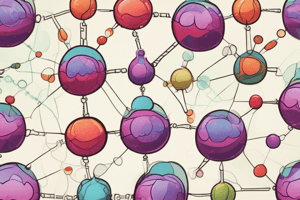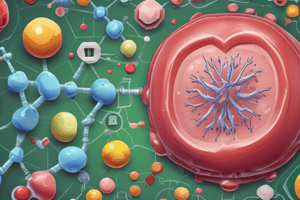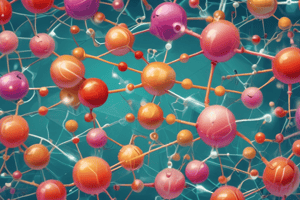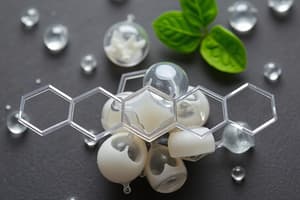Podcast
Questions and Answers
What is the characteristic of the double bonds in unsaturated fatty acids?
What is the characteristic of the double bonds in unsaturated fatty acids?
- They are always spaced at two carbon intervals
- They are always present at the end of the hydrocarbon tail
- They are always in the trans configuration
- They are nearly always in the cis configuration (correct)
What is the effect of introducing a cis double bond in a fatty acid?
What is the effect of introducing a cis double bond in a fatty acid?
- It has no effect on the shape of the acid
- It makes the acid straighter at that position
- It increases the melting point of the fatty acid
- It causes the acid to bend or 'kink' at that position (correct)
What is the relationship between the number of double bonds and the melting point of a fatty acid?
What is the relationship between the number of double bonds and the melting point of a fatty acid?
- The more double bonds, the higher the melting point
- The fewer double bonds, the lower the melting point
- The more double bonds, the lower the melting point (correct)
- There is no correlation between the two
What is the characteristic of the length of the hydrocarbon tail and the melting point of a fatty acid?
What is the characteristic of the length of the hydrocarbon tail and the melting point of a fatty acid?
What is the role of α-Linolenic acid (plant omega-3) in the body?
What is the role of α-Linolenic acid (plant omega-3) in the body?
What is the central architectural feature of biological membranes?
What is the central architectural feature of biological membranes?
What is the primary function of bile acids in the intestine?
What is the primary function of bile acids in the intestine?
What is the role of cholesterol in myelin sheath?
What is the role of cholesterol in myelin sheath?
What is the precursor molecule for the synthesis of vitamin D and steroid hormones?
What is the precursor molecule for the synthesis of vitamin D and steroid hormones?
What is the primary source of acetyl-CoA for cholesterol synthesis?
What is the primary source of acetyl-CoA for cholesterol synthesis?
What is the first step in the biosynthesis of cholesterol?
What is the first step in the biosynthesis of cholesterol?
What is the target of statins in cholesterol synthesis?
What is the target of statins in cholesterol synthesis?
In which tissue are maximum amounts of glycolipids found?
In which tissue are maximum amounts of glycolipids found?
What is the role of gangliosides in the body?
What is the role of gangliosides in the body?
What is the origin of the five-carbon ring in prostaglandins?
What is the origin of the five-carbon ring in prostaglandins?
What is the effect of PGE and PGI on blood pressure?
What is the effect of PGE and PGI on blood pressure?
Which of the following is a function of prostaglandins?
Which of the following is a function of prostaglandins?
What is the origin of the name 'prostaglandin'?
What is the origin of the name 'prostaglandin'?
What serves as an intracellular second messenger system in cells?
What serves as an intracellular second messenger system in cells?
What is the primary function of sphingolipids in cells?
What is the primary function of sphingolipids in cells?
What is the characteristic of sphingolipids that distinguishes them from other membrane lipids?
What is the characteristic of sphingolipids that distinguishes them from other membrane lipids?
What is the characteristic of cerebrosides and globosides?
What is the characteristic of cerebrosides and globosides?
What is the characteristic of gangliosides?
What is the characteristic of gangliosides?
What is the common component of sphingolipids?
What is the common component of sphingolipids?
What is the product of the phosphorylation and decarboxylation of mevalonate?
What is the product of the phosphorylation and decarboxylation of mevalonate?
What is the result of the condensation reaction between geranyl pyrophosphate and isopentenyl diphosphate?
What is the result of the condensation reaction between geranyl pyrophosphate and isopentenyl diphosphate?
What is the enzyme responsible for converting squalene to 2,3-oxidosqualene?
What is the enzyme responsible for converting squalene to 2,3-oxidosqualene?
What is the immediate product of the cyclization of 2,3-oxidosqualene?
What is the immediate product of the cyclization of 2,3-oxidosqualene?
Where does the formation of cholesterol from lanosterol take place?
Where does the formation of cholesterol from lanosterol take place?
What is the result of the condensation of two molecules of farnesyl diphosphate?
What is the result of the condensation of two molecules of farnesyl diphosphate?
Flashcards are hidden until you start studying
Study Notes
Inositol Triphosphate and Diacylglycerol
- Generated from phosphatidyl inositol biphosphate, serving as an intracellular second messenger system.
- Plays a role in anchoring certain proteins to the cell membrane.
Sphingolipids Overview
- Fourth major class of membrane lipids, alongside phospholipids, glycolipids, and cholesterol.
- Composed of sphingosine, long-chain fatty acid, and a polar head group without glycerol.
Classification of Sphingolipids
- Derivatives of ceramide with varying head groups.
- Sphingomyelins: Contain phosphocholine or phosphoethanolamine.
- Glycosphingolipids:
- Cerebrosides: One monosaccharide linked to ceramide.
- Globosides: Two or more monosaccharides linked.
- Gangliosides: Complex lipids with oligosaccharides and sialic acid residues.
Functions of Cholesterol
- Polar derivatives form bile acids, acting as detergents to emulsify dietary fats.
- Integral to the myelin sheath in neurons, aiding impulse conduction.
- Precursor for vitamin D and steroid hormones (cortisol, aldosterone, progesterone, estrogens, testosterone).
Cholesterol Synthesis Steps
-
Step 1: Biosynthesis of Mevalonate
- Acetyl-CoA condenses to form acetoacetyl-CoA.
- HMG-CoA synthesized; its reduction to mevalonate is the primary regulatory step, inhibited by statins.
-
Step 2: Formation of Squalene
- Involves conversion of mevalonate to farnesyl pyrophosphate and then to squalene.
Unsaturated Fatty Acids
- Monounsaturated contains one double bond; polyunsaturated contains multiple.
- Double bonds often in cis configuration, causing "kinks."
- Melting point is influenced by the number and configuration of double bonds and fatty acid tail length.
Essential Fatty Acids
- Cannot be synthesized by the body; must be obtained from diet.
- α-Linolenic acid (omega-3) is a precursor for long-chain PUFAs (EPA, DHA).
- Linoleic acid is a precursor for omega-6 fatty acid arachidonic acid.
Structural Lipids in Cell Membranes
- Biological membranes feature a lipid bilayer, preventing polar molecules' passage.
- Glycolipids are abundant in nervous tissue; galactocerebrosides found in myelin.
Functions of Sphingolipids
- Important for cell-cell interaction, growth, and development.
- Antigenic properties linked to tumors and blood group antigens.
- Gangliosides act as receptors for toxins and pathogens (e.g., cholera toxin).
Eicosanoids
- Prostaglandins: Contain a five-carbon ring derived from arachidonic acid.
- Control blood pressure and act as inflammatory mediators by increasing capillary permeability.
Synthesis of Prostaglandins
- Involves sequential phosphorylation and decarboxylation of mevalonate to yield isopentenyl diphosphate and subsequently farnesyl pyrophosphate.
Final Steps in Cholesterol Formation
- Squalene undergoes cyclization to form lanosterol, then is converted into cholesterol in the endoplasmic reticulum.
Studying That Suits You
Use AI to generate personalized quizzes and flashcards to suit your learning preferences.




